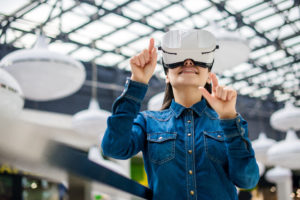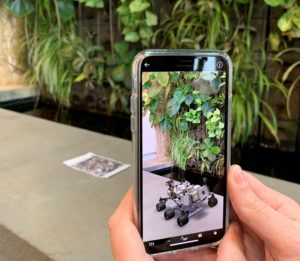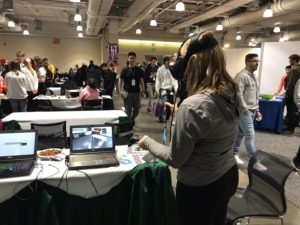The South Pole was exactly as I expected—snowy and barren, apart from the giant research station in front of me. Suddenly, I got a notification in my communication system that there was a strong signal coming from the sky. I looked up and changed the visual display settings of my goggles to find stunning views of the Solar System, all the way past Pluto. My heads-up display told me that I’ve discovered a subatomic particle, called a neutrino, that flies through the fabric of space at nearly the speed of light. I wanted to find the source of this neutrino, so I switched my display to X-ray vision. The signal brightened, and the source was revealed—a massive black hole. I captured as much data as possible so I could report back to the lead scientist on the project. What an exciting afternoon of research!
Okay, I’ve never actually been to the South Pole, but I experienced this event in virtual reality at a conference expo booth for the National Science Foundation. This experience put me in the shoes of an astrophysicist working at the IceCube Neutrino Detection Facility, operated by UW-Madison researchers. As someone who specializes in the life sciences, I had the opportunity to learn more about an area outside my expertise—the fascinating world of particle physics.

Most people think of augmented reality (AR) and virtual reality (VR) in the context of gaming or entertainment. You’ve likely had a casual AR experience if you’ve ever given yourself a flower crown in Snapchat, or hunted for Charmander at your local park with the Pokémon GO app. Yet, as I experienced at a conference several weeks ago, AR and VR can have massive implications for education and training experiences in the sciences.
Bringing Science to Life
Earlier this week, I attended a workshop on AR/VR with several other Promega colleagues presented by Nick Klein, Director of Innovation at iSO-FORM, a digital media company whose mission is “to bring science to life; to bring function to form.” He led us through the process of concepting and designing digital solutions for scientific problems.
“Extended reality experiences allow us to visualize and interact with structures, processes, and environments in ways that aren’t possible or practical in physical reality. These tools allow us to tell science stories in controllable, purpose-driven contexts that don’t need to be constrained by real-world limitations like time, scale, or physical location.” –Nick Klein, iSO-FORM

Nick showed us how AR technology is being used to digitally impose images of objects into a real physical space by using markers, called glyphs, that the AR program can detect. NASA released an educational app called Spacecraft 3D that uses this technology.
Now imagine needing to purchase a new sequencing instrument, but you have doubts about how it would fit into your lab space. In our workshop, we brainstormed the possibility of using AR to create an app that could help you visualize a digital version of the sequencer imposed onto the camera footage of your lab bench using an AR glyph marker. It sounds like science fiction, but researchers are just beginning to scratch the surface of possibilities for implementing AR and VR into the field of science.
Creating a Virtual Lab
My colleague, Darcia Schweitzer, had her own VR experience while attending the iGEM Giant Jamboree last month. This epic science fair-like event brought together teams of high school, undergraduate, and graduate students working to create solutions to problems in synthetic biology. There she met Team TU Delft from the Netherlands, who presented to a standing-room only audience on their research in detecting gene doping—a rising threat of performance enhancement in sports. In doing their research, Team TU Delft also recognized that laboratory training can be expensive; it is time-consuming, creates waste, and takes up precious lab bench space. So they went above and beyond to create a virtual training experience to educate users on the method they use to conduct experiments in the lab.

Using photographs of their actual lab, the team developed an interactive CGI model of the lab space. They created a VR experience that was as clear and simple as possible, while maintaining the accuracy of the method. They wanted to incorporate the whole scientific process, from putting on a lab coat, to doing part of the experiment, then visualizing data printed on posters hanging on the walls of the digital space. Darcia said:
“The VR lab training was more realistic than I anticipated. The joystick even had a double stop that functioned exactly like a micropipette. It was nice that they were able to incorporate a few lab safety steps, included putting on a lab coat and washing your hands. I could see how an entire VR experience just to train someone in lab safety could be very valuable (adding in putting on goggles and gloves, along with things like proper waste disposal and working under a hood). As a former teacher, I would have loved to have access for something like this to train students in pipetting technique before actually giving them the tools and materials—I can definitely see how it would cut down on waste by providing students/trainees with multiple opportunities to practice before trying it ‘for real.’”
The team earned a Gold Medal at iGEM and won Overgrad Special Awards for Best Product Design and Best New Application Project. TU Delft doesn’t view this experience as a gimmick either. The students met with university stakeholders to learn what is most valuable in a training module, and they are moving forward with implementing VR training in other departments at the university. As technology advances, experiences such as this one will become even more realistic and detailed.
The Blurred Realities of the Future
In a consumer-driven world, we are constantly being bombarded with advertisements. But recent trends have shown that people are looking for valuable experiences, they don’t want to be ad targets. Whether used for education, training, or awareness, immersive experiences like AR and VR will continue to grow. Nick Klein says, “The biggest and most significant mid-term trend is the blurring of the lines on the reality-virtuality continuum.” As AR, VR, and other mixed reality experiences become more commonplace, it creates more opportunities for discovery. Hopefully, engaging with scientific concepts in education and using virtual tools in scientific research will make the world a better place. Though, the ubiquitous use of these technologies also raises questions about how we will perceive reality in the future. “Within a generation or two, I think humans are going to start having a hard time differentiating between physical and digital realities,” says Nick. Since extended reality experiences are new for many of us, the future is still unclear as to how it will shape our culture. Only time will tell as we focus our eyes for the virtual world to come into view.
Latest posts by Mariel Mohns (see all)
- Sustainability Makeover: Parking Ramp Edition - January 27, 2020
- Go with Your Gut: Understanding How the Microbiome and Diet Influence Health - November 26, 2019
- Kyle Hill Explains the Science of Star Wars at the Wisconsin Science Festival - October 23, 2019
